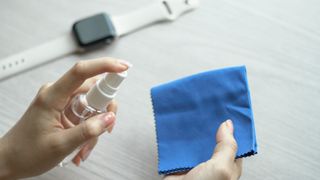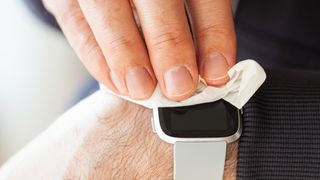
Fitness trackers and smartwatches are made to be worn all day and all night, and over time they start to get dirty. Eventually, the band will begin to look grubby, and the case will start to accumulate grime.
Not only is that gross, it also means your device might not work as well as it should. Dirty electrical contacts can stop smartwatches charging properly, and grime on the back of the watch case can disrupt the signal from the optical heart rate monitor. It can also lead to skin irritation, particularly if sweat has accumulated and dried on.
Thankfully, keeping things nice and clean is pretty simple, and most of the time you'll need nothing more than a little rubbing alcohol, a lint-free cloth, and perhaps a soft toothbrush.
Never use bleach, or anything abrasive that could dull or damage the finish of your watch, such as cream cleaners that contain rough particles to scrub away dirt, wire brushes, or scouring pads. Some smartwatches and fitness trackers have holes in the case for microphones, speakers, lights, or reset buttons. Never poke into these, or you risk damaging its internal components.
It's worth bearing in mind, however, that fitness trackers and smartwatches are made from a wide range of different materials, including resin, silicone, stainless steel, aluminum, and titanium to name just a handful, and not all can be cleaned the same way. It's always a good idea to follow your device manufacturer's instructions, which is why we've put together this guide rounding up tips from four of the biggest names in smartwatches and fitness trackers.
Cleaning your Apple Watch
The official care advice for Apple Watches advises using a dry, lint-free cloth for everyday cleaning. If it needs a deeper clean, remove any special bands (such as leather straps), then either wipe the watch with a damp cloth or rinse it under warm, lightly running water. When you're done, dry it carefully before wearing.
You can also clean the Digital Crown under running water, turning and pressing it while the water flows over it to remove any accumulated grime. Again, give it a thorough dry with a clean cloth, making sure you soak up any water that's gathered between the crown and the watch case.
Get daily insight, inspiration and deals in your inbox
Get the hottest deals available in your inbox plus news, reviews, opinion, analysis and more from the TechRadar team.
If you use one of Apple's silicone watch bands, you can freshen it up with mild, hypoallergenic hand soap and water.

Cleaning your Fitbit
Fitbit offers some sensible guidance on keeping your fitness tracker's electrical contacts in good working order. You can clean the contacts on the watch and the pins on the charger using rubbing alcohol, then finish off with a dry cloth or tissue (being careful not to leave any scraps of lint behind).
Make sure everything is totally dry before trying to charge your device, and never scraps the contacts with anything metal, as this could damage the plating.
When it comes the the silicone band, Fitbit advises avoiding anything harsh like hand sanitizer, dish soap, or hand soap. If your band is looking grubby, you can clean it using fresh water and a gentle soap-free cleanser.

Cleaning your Garmin watch
Garmin watches are known for being super tough, and they'll last even longer with the right TLC. Garmin has comprehensive advice on caring for your device to help keep it in good condition, and avoid skin irritation.
One of the most important tips (and one that's easy to forget) is to always rinse off your watch and allow it to dry after a sweaty workout. If your watch has a leather or suede band, switch to a silicone one before you get stuck into some heavy activity.
Metal and leather bands can be cleaned with a dry or damp lint-free cloth, nylon bands can be rinsed, and silicone or TPU elastomer can be rinsed or wiped with a little rubbing alcohol if you need to remove residue like insect repellent or sunscreen.
You can keep the case clean by rinsing it, or using a damp cloth. A soft toothbrush is a good choice if you need to clean the contacts, but don't poke the bristles (or anything else) into microphone or speaker openings like those on the Garmin Venu 2 Plus.
Garmin advises that you can also clean the outside of the watch case with a 70% isopropyl alcohol wipe or a disinfectant wipe, but it's wise to rinse and dry it afterwards so to avoid irritating your skin.

Cleaning your Amazfit watch
Amazfit makes some of the most affordable running watches on the market, but they're solidly built and should last many years with proper care. The company doesn't give instructions for all its various devices, but its tips on caring for the Amazfit Pace should be useful in most instances.
First, the company advises gently cleaning the heart rate sensor on the back of the watch using a cotton swab dipped in rubbing alcohol, then wiping with a clean cloth to dry it.
For the charging contacts on the watch and the pins on the charger, it recommends using a toothpick or toothbrush to remove any debris, then following up with your trusty cotton swab and alcohol. The band can be cleaned with rubbing alcohol too, applied to either a swab or a cloth.
Some Amazfit devices, such as the T-Rex Pro, have optional bands made from leather rather than silicone. The company advises avoiding getting leather bands wet, and avoiding contact between light colored bands and dark clothing in case dye transfers onto the strap.
If your Amazfit device is suitable for swimming and showering, always make sure you rinse and dry it afterwards. That's sound advice for any fitness tracker or smartwatch to avoid corrosion or skin irritation.
- On a budget? Check out the best cheap running watches
Cat is the editor of TechRadar's sister site Advnture. She’s a UK Athletics qualified run leader, and in her spare time enjoys nothing more than lacing up her shoes and hitting the roads and trails (the muddier, the better)

